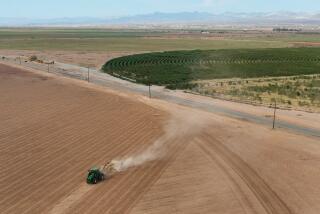Federal Weather Experts See More of Same Ahead
WASHINGTON — For Californians in search of respite from the winter’s lashing rains and raw temperatures comes this word of dubitable cheer from the government’s most senior weather forecasters: It isn’t necessarily going to get worse over the next two months. Then again, there’s no sign it will get better.
Conditions in the tropical Pacific, which are fueling the winter-long foul weather pattern and which allowed forecasters to predict the initial onslaught well before it began, are ripe for producing yet more severe rainstorms and cool temperatures, the government said Thursday.
“El Nino is still going strong. . . . The next two months will bring conditions which are similar to the last two months of abnormal weather,” said Commerce Secretary William M. Daley, whose purview includes the nation’s weather agency, the National Oceanic and Atmospheric Administration.
But, the weather team said, there is this ray of sunshine: There is no indication that the climatic phenomenon known as La Nina--a follow-up to El Nino that brings abnormally dry and warm conditions, and potential drought--will occur next year.
Although some scientists question whether the most recent bout of foul weather to make life in California miserable--and in some cases fatally dangerous--can be attributed to El Nino, additional “episodic events,” whatever the name they go by, will occur, said Ants Leetmaa, director of the agency’s Climate Prediction Center.
That, he said at a news conference, means “periods when it dries out [and] periods of very heavy storms like we’ve seen in the past.”
This is because the temperatures on the surface of the tropical eastern Pacific are well above normal and are expected to stay so perhaps into May, Leetmaa said.
The phenomenon was noticed last March, when temperature-monitoring buoys and satellites found indications of abnormal, significant warming of the ocean surface. Since June, the temperature of these waters has averaged 8 degrees Fahrenheit above normal, the agency said.
*
That sends warm, moist air aloft, playing havoc with the upper-air winds known as the jet stream, which direct global weather patterns.
Thus the impact reaches around the world: Rainfall in Southeast Asia is 25% below normal this season, and precipitation that would normally be falling on Indonesia is instead an ocean away in California.
The result, according to government statistics, is by now well-known to most California residents: high surf, powerful winds and heavy rain in southern regions, and annual seasonal totals of rainfall already reached, before the second month of the year is over, in some Northern and Central California communities.
While the rainfall is not yet setting records statewide, the government experts said California appears headed for a rainy season among the worst 10 or so over the past 104 years.
Elsewhere, the disruption has been equally significant, the atmospheric agency said. Temperatures from November to January in Chicago, Minneapolis, Bismarck, N.D., and Buffalo, N.Y., have averaged 2 to 4 degrees Fahrenheit above normal. Indeed, Bismarck’s average temperature was 28.5 in December, a month when the historical average is 15.3.
In the Southeast, the weather phenomenon has meant record rainfall--19.58 inches from November to January in Tampa, Fla., swamping the record of 12.93 inches set in 1926-27.
“The severe weather in California and the southeast United States unfortunately will continue,” Daley said. “Much of the South will see increased rainfall and cooler temperatures. And much of the rest of the country will continue to see warmer weather than normal.”
Daley said damage estimates from El Nino so far this season have ranged from $250 million to $1 billion in the nation. He said the particularly severe El Nino of 1982-83, to which the current pattern has been compared, caused total U.S. destruction valued at $2.5 billion. He noted that property values have risen since then.
In California, he said, the damage this winter has been estimated at $300 million to $500 million so far.
It may be of no consolation to Californians or others suffering the often devastating effects of such weather, but the warmer temperatures elsewhere have brought a 10% reduction in heating bills nationally, Leetmaa said. And because the country may be using fewer gallons of heating oil, gasoline prices are being held in check, he added.
Having arrived at his news conference without a topcoat on an abnormally mild February morning in the nation’s capital, he said: “Today is a very pleasant day. We can thank El Nino for that.”
More to Read
Sign up for Essential California
The most important California stories and recommendations in your inbox every morning.
You may occasionally receive promotional content from the Los Angeles Times.










